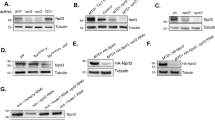Abstract
Anchor away is a sequestering method designed to acutely and timely abrogate the function of a protein of interest by anchoring to a cell compartment different from its target. This method induces the binding of the target protein to the anchor by either the addition of rapamycin to Drosophila food or cell media. Rapamycin mediates the formation of a ternary complex between the anchor, which is tagged with the FK506-binding protein (FKBP12), and the target protein fused with the FKB12 rapamycin-binding (FRB) domain of mammalian target of rapamycin (mTOR). The rapamycin-bound target protein stays sequestered away from its compartment, where it cannot perform its biological function.
Access this chapter
Tax calculation will be finalised at checkout
Purchases are for personal use only
Similar content being viewed by others
References
Cooley L, Kelley R, Spradling A (1988) Insertional mutagenesis of the Drosophila genome with single P elements. Science 239:1121–1128
Adams MD, Sekelsky JJ (2002) From sequence to phenotype: reverse genetics in Drosophila melanogaster. Nat Rev Genet 3:189–198
Boutros M, Ahringer J (2008) The art and design of genetic screens: RNA interference. Nat Rev Genet 9:554–566
Harmansa S, Alborelli I, Bieli D, Caussinus E, Affolter M (2017) A nanobody-based toolset to investigate the role of protein localization and dispersal in Drosophila. Elife 6:99
Haruki H, Nishikawa J, Laemmli UK (2008) The anchor-away technique: rapid, conditional establishment of yeast mutant phenotypes. Mol Cell 31:925–932
Caussinus E, Kanca O, Affolter M (2011) Fluorescent fusion protein knockout mediated by anti-GFP nanobody. Nat Struct Mol Biol 19:117–121
Ding L, Laor D, Weisman R, Forsburg SL (2014) Rapid regulation of nuclear proteins by rapamycin-induced translocation in fission yeast. Yeast 31:253–264
Sanchez Bosch P, Pepperl J, Basler K (2020) Anchor away – a fast, reliable and reversible technique to inhibit proteins in Drosophila melanogaster. G3 (Bethesda) 10:1745–1752
Port F, Bullock SL (2016) Creating heritable mutations in Drosophila with CRISPR-Cas9. Methods Mol Biol 1478:145–160
Restrepo S, Zartman JJ, Basler K (2016) Cultivation and live imaging of Drosophila imaginal discs. Methods Mol Biol 1478:203–213
Port F, Chen HM, Lee T, Bullock SL (2014) Optimized CRISPR/Cas tools for efficient germline and somatic genome engineering in Drosophila. Proc Natl Acad Sci U S A 111:E2967–76
Zhang H, Stallock JP, Ng JC, Reinhard C, Neufeld TP (2000) Regulation of cellular growth by the Drosophila target of rapamycin dTOR. Genes Dev 14:2712–2724
Toba G, Ohsako T, Miyata N, Ohtsuka T, Seong KH, Aigaki T (1999) The gene search system. A method for efficient detection and rapid molecular identification of genes in Drosophila melanogaster. Genetics 151:725–737
Author information
Authors and Affiliations
Corresponding author
Editor information
Editors and Affiliations
Rights and permissions
Copyright information
© 2022 The Author(s), under exclusive license to Springer Science+Business Media, LLC, part of Springer Nature
About this protocol
Cite this protocol
Sanchez Bosch, P. (2022). Anchor Away: A System for Fast Inhibition of Proteins in Drosophila. In: Dahmann, C. (eds) Drosophila. Methods in Molecular Biology, vol 2540. Humana, New York, NY. https://doi.org/10.1007/978-1-0716-2541-5_11
Download citation
DOI: https://doi.org/10.1007/978-1-0716-2541-5_11
Published:
Publisher Name: Humana, New York, NY
Print ISBN: 978-1-0716-2540-8
Online ISBN: 978-1-0716-2541-5
eBook Packages: Springer Protocols




